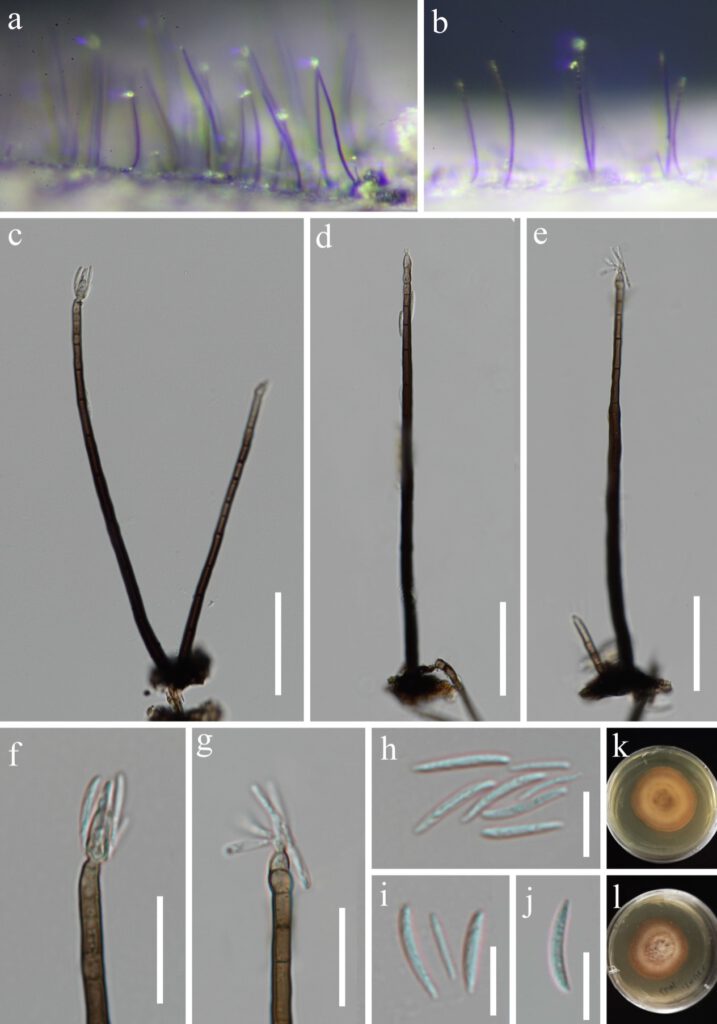Dictyochaeta guizhouensis J.Y. Zhang & Y.Z. Lu, in Zhang, Ma, Xiao, Boonmee, Kang & Lu, Journal of Fungi 8(no. 643): 19 (2022)
Index Fungorum number: IF559699; Facesoffungi number: FoF 11040;
Etymology – Referring to the province “Guizhou” where this species was collected.
Holotype – HKAS 123753
Saprobic on dead wood in the land. Sexual morph: Undetermined. Asexual morph: hyphomycetous. Colonies on natural substrate superficial, effuse, gregarious, hairy, brown. Conidiophores 133–240 × 4–6.8 µm (x̅ = 170.7 × 4.8 µm, n = 10), mononematous, macronematous, erect, straight, unbranched, multiseptate, smooth, dark brown at the base, becoming pale brown towards the apex. Conidiogenous cells 8.6–20 × 2.9–4.8 µm (x̅ = 14.8 × 3.8 µm, n = 10), polyblastic, terminal, integrated, with flared collarette, cylindrical, pale brown to subhyaline or hyaline towards the apex. Conidia 13–16 × 1.5–2.2 µm (x̅ = 15 × 1.8 µm, n = 20), aggregated in a glistening and small mass of conidia at the tip of conidiophores, amerospores, acrogenous, asymmetrical, falcate, straight or slightly curved, often rounded at the apex, tapering toward the basal end, rough-walled, hyaline.
Cultural characteristics – Conidia germinating on PDA within 15 h and germ tubes produced from conidia. Colonies grew on PDA medium at 25°C, circular, with an entire margin, umbonate, with dense, white mycelium in the middle and yellowish-brown mycelium in the outer ring on the surface; in reverse cream yellow in the middle, while yellowish-brown in the centre and the outer ring.
Material examined – CHINA, Guizhou province, Xishui county, Xishui Reserve, 7 September 2020, Yong-Zhong. Lu, XSBHq(011) (HKAS xxx, holotype; GZAAS 22-0074), ex-type living culture, GZCC 22-0083.
GenBank accession numbers – LSU: ON502892, ITS: ON502899.
Notes: In a BLASTn search in GenBank, the closest match of the LSU and ITS sequence of our new isolate (GZCC 22-0083) were 100% similarity across 100% of the query sequence and 98.49% similarity across 90% of the query sequence to Dictyochaeta sp. (strain CBS 138684), respectively. The phylogenetic tree showed that our new collection is phylogenetically closely related to Dictyochaeta sp. with strong support (96% ML/1.0 PP, Figure 1). Dictyochaeta sp. (CBS 138684) was described by Réblová et al. (2021d) with its sexual and asexual morphs. Based on the insufficient evidence of morphological characteristics due to sample ageing, Dictyochaeta sp. (strain CBS 138684) was tentatively designated as an unidentified species in the genus Dictyochaeta (Réblová et al. 2021d). Our new isolate formed an asexual morph in the natural substrate and is characterized by lacking setae and microconidia, polyphialidic conidiogenous cells with conspicuous collarette, which can differentiate from Dictyochaeta sp. (CBS 138684). Given the remark differences in morphology between our new collection (HKAS 123753) and Dictyochaeta sp (CBS 138684), we keep Dictyochaeta sp. as an unidentified species and introduced our new collection as a novel species in Dictyochaeta.

Figure 1. Dictyochaeta guizhouense (HKAS 123753, holotype). (a,b) Colonies on dead wood; (c–e) Conidiophores; (f, g) Conidiogenous cells; (h–j) Conidia. Scale bars: (c–e) 50 μm; (f,g) 20 μm; (h–j) 10 μm.
